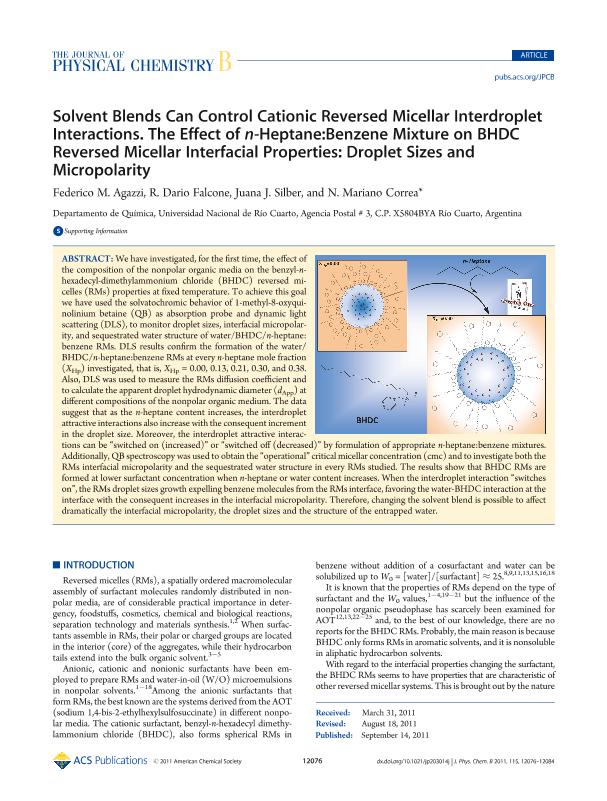Mostrar el registro sencillo del ítem
dc.contributor.author
Agazzi, Federico Martin

dc.contributor.author
Falcone, Ruben Dario

dc.contributor.author
Silber, Juana J.
dc.contributor.author
Correa, Nestor Mariano

dc.date.available
2023-04-13T15:05:35Z
dc.date.issued
2011-09
dc.identifier.citation
Agazzi, Federico Martin; Falcone, Ruben Dario; Silber, Juana J.; Correa, Nestor Mariano; Solvent blends can control cationic reversed micellar interdroplet interactions. the effect of n- heptane:Benzene mixture on BHDC reversed micellar interfacial properties: Droplet sizes and micropolarity; American Chemical Society; Journal of Physical Chemistry B; 115; 42; 9-2011; 12076-12084
dc.identifier.issn
1089-5647
dc.identifier.uri
http://hdl.handle.net/11336/193732
dc.description.abstract
We have investigated, for the first time, the effect of the composition of the nonpolar organic media on the benzyl-n-hexadecyl-dimethylammonium chloride (BHDC) reversed micelles (RMs) properties at fixed temperature. To achieve this goal we have used the solvatochromic behavior of 1-methyl-8-oxyquinolinium betaine (QB) as absorption probe and dynamic light scattering (DLS), to monitor droplet sizes, interfacial micropolarity, and sequestrated water structure of water/BHDC/n-heptane:benzene RMs. DLS results confirm the formation of the water/BHDC/n-heptane:benzene RMs at every n-heptane mole fraction (X Hp) investigated, that is, XHp = 0.00, 0.13, 0.21, 0.30, and 0.38. Also, DLS was used to measure the RMs diffusion coefficient and to calculate the apparent droplet hydrodynamic diameter (dApp) at different compositions of the nonpolar organic medium. The data suggest that as the n-heptane content increases, the interdroplet attractive interactions also increase with the consequent increment in the droplet size. Moreover, the interdroplet attractive interactions can be "switched on (increased)" or "switched off (decreased)" by formulation of appropriate n-heptane:benzene mixtures. Additionally, QB spectroscopy was used to obtain the "operational" critical micellar concentration (cmc) and to investigate both the RMs interfacial micropolarity and the sequestrated water structure in every RMs studied. The results show that BHDC RMs are formed at lower surfactant concentration when n-heptane or water content increases. When the interdroplet interaction "switches on", the RMs droplet sizes growth expelling benzene molecules from the RMs interface, favoring the water-BHDC interaction at the interface with the consequent increases in the interfacial micropolarity. Therefore, changing the solvent blend is possible to affect dramatically the interfacial micropolarity, the droplet sizes and the structure of the entrapped water.
dc.format
application/pdf
dc.language.iso
eng
dc.publisher
American Chemical Society

dc.rights
info:eu-repo/semantics/openAccess
dc.rights.uri
https://creativecommons.org/licenses/by-nc-sa/2.5/ar/
dc.subject
Solvent blends
dc.subject
BHDC
dc.subject
Reverse micelles
dc.subject
interfacial properties
dc.subject.classification
Físico-Química, Ciencia de los Polímeros, Electroquímica

dc.subject.classification
Ciencias Químicas

dc.subject.classification
CIENCIAS NATURALES Y EXACTAS

dc.title
Solvent blends can control cationic reversed micellar interdroplet interactions. the effect of n- heptane:Benzene mixture on BHDC reversed micellar interfacial properties: Droplet sizes and micropolarity
dc.type
info:eu-repo/semantics/article
dc.type
info:ar-repo/semantics/artículo
dc.type
info:eu-repo/semantics/publishedVersion
dc.date.updated
2023-04-11T14:34:51Z
dc.journal.volume
115
dc.journal.number
42
dc.journal.pagination
12076-12084
dc.journal.pais
Estados Unidos

dc.description.fil
Fil: Agazzi, Federico Martin. Universidad Nacional de Río Cuarto. Facultad de Ciencias Exactas Fisicoquímicas y Naturales. Departamento de Química; Argentina. Consejo Nacional de Investigaciones Científicas y Técnicas. Centro Científico Tecnológico Conicet - Córdoba; Argentina
dc.description.fil
Fil: Falcone, Ruben Dario. Universidad Nacional de Río Cuarto. Facultad de Ciencias Exactas Fisicoquímicas y Naturales. Departamento de Química; Argentina. Consejo Nacional de Investigaciones Científicas y Técnicas. Centro Científico Tecnológico Conicet - Córdoba; Argentina
dc.description.fil
Fil: Silber, Juana J.. Universidad Nacional de Río Cuarto. Facultad de Ciencias Exactas Fisicoquímicas y Naturales. Departamento de Química; Argentina
dc.description.fil
Fil: Correa, Nestor Mariano. Universidad Nacional de Río Cuarto. Facultad de Ciencias Exactas Fisicoquímicas y Naturales. Departamento de Química; Argentina. Consejo Nacional de Investigaciones Científicas y Técnicas. Centro Científico Tecnológico Conicet - Córdoba; Argentina
dc.journal.title
Journal of Physical Chemistry B

dc.relation.alternativeid
info:eu-repo/semantics/altIdentifier/doi/http://dx.doi.org/10.1021/jp203014j
dc.relation.alternativeid
info:eu-repo/semantics/altIdentifier/url/https://pubs.acs.org/doi/10.1021/jp203014j
Archivos asociados
